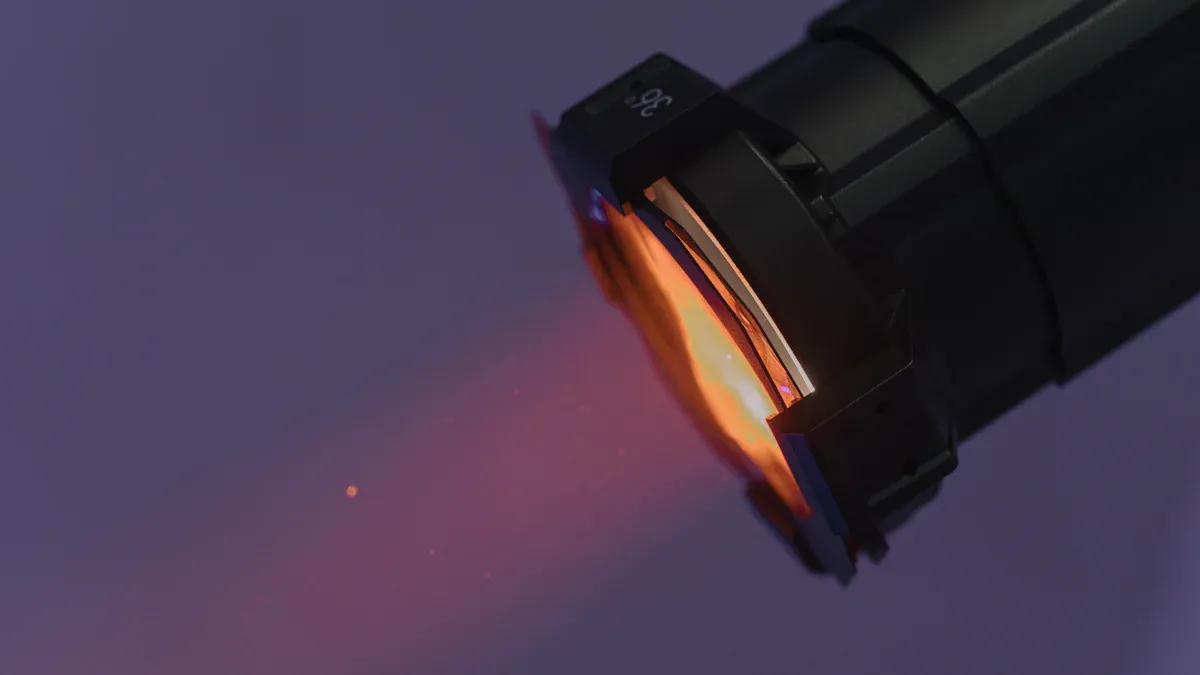The Role of the Reflector in Flashlight Performance and How to Maintain It

The reflector plays a vital role in your flashlight's performance. It focuses and directs light, ensuring a steady beam. A well-maintained reflector can influence up to 70% of the flashlight's efficiency. Neglecting it may reduce brightness and energy efficiency. For your helius flashlight, proper care ensures consistent and reliable lighting.
Key Takeaways
The reflector is important for how a flashlight works. It focuses light to make a steady beam. A clean reflector can improve brightness by 70%.
Check your flashlight's reflector often for scratches or damage. This keeps the light bright and the beam focused.
Clean the reflector gently with compressed air or a Q-tip with alcohol. Do not use cloths, as they might scratch it and lower the light output.
Understanding the Reflector in a Flashlight

What Is a Reflector?
A reflector is a crucial component inside a flashlight that helps shape and direct the light emitted by the LED or bulb. It is typically a curved surface, often coated with a reflective material, designed to gather and redirect light into a focused beam of light. Without a reflector, the light would scatter in all directions, reducing the flashlight's efficiency and brightness. Reflectors are made from materials like aluminum alloy, high-temperature plastic, or polycarbonate. Aluminum reflectors are durable and heat-resistant, while plastic options are lightweight and cost-effective.
The Purpose of a Reflector in Flashlight Design
The reflector plays a vital role in flashlight design by enhancing the beam's focus and quality. It ensures that the light is directed forward, creating a concentrated and efficient beam. This design improves brightness and allows the flashlight to illuminate distant objects effectively. Reflectors also help reduce energy waste by minimizing light dispersion. In modern flashlights, the reflector design works in harmony with LEDs to produce a clear and consistent beam, making it an essential element for optimal performance.
Common Reflector Designs in Flashlights
Flashlights use various reflector designs to achieve different lighting effects. Smooth reflectors are popular for their ability to maximize throw distance, making them ideal for long-range illumination. However, they may create beam artifacts. Textured reflectors, on the other hand, provide a smoother beam with fewer dark spots. They diffuse light evenly, which is useful for close-range tasks requiring detail visibility. Some high-end flashlights combine these designs to balance throw and beam quality. The choice of reflector design depends on the flashlight's intended use and the user's preferences.
How Reflector Design Enhances Flashlight Performance

The Role of Reflector Design in Beam Focus
The reflector in a flashlight plays a critical role in shaping the beam. Its design determines how the light is redirected and focused. A well-designed reflector ensures that the light from the LED is concentrated into a focused beam of light. This focus allows you to illuminate objects at a distance with precision. Smooth reflectors are often used for long-range applications because they create a tight beam. Textured reflectors, however, scatter light more evenly, making them ideal for close-range tasks. The choice of reflector design depends on your needs, whether you require a narrow beam or a broader spread of light.
Impact on Light Quality and Brightness
The quality and brightness of the light depend heavily on the reflector's design. Several factors influence this, including the diameter, depth, and surface quality of the reflector:
Larger or deeper reflectors can increase light throw but may not always be better.
A high-quality smaller reflector often outperforms a larger one with poor surface quality.
Reflectors with advanced coatings enhance brightness by reducing light loss.
These features ensure that your flashlight delivers powerful illumination while maintaining a consistent beam.
Contribution to Energy Efficiency in Flashlights
Reflector advancements have significantly improved flashlight performance. Modern reflectors use better materials and coatings to increase reflectivity. This improvement reduces energy waste, allowing your flashlight to operate more efficiently. Anti-reflective coatings further enhance light throughput, ensuring that more light reaches the beam. With these innovations, high-performance lights can achieve greater efficiency without compromising brightness or beam quality.
Maintaining Your Flashlight Reflector for Optimal Performance
Cleaning the Reflector: Tools and Techniques
Proper cleaning is essential for maintaining your flashlight's reflector and ensuring optimal performance. However, cleaning requires care to avoid damaging the reflective surface. Avoid wiping the reflector with any cloth, even soft ones, as this can scuff the surface and reduce its ability to direct light effectively. Instead, follow these steps for safe cleaning:
Use compressed air to gently blow away dust or debris. Be cautious, as some canned air products may contain fluorocarbons or oils that leave residue.
If dust persists, lightly use a Q-tip for spot cleaning. Handle it with extreme care to avoid scratching the surface.
For stubborn dirt, rinse the reflector with hot isopropanol and follow up with deionized water. This method is effective but labor-intensive.
Remember, cleaning should only be done when absolutely necessary. Routine maintenance tips like storing your flashlight in a clean, dry place can minimize the need for frequent cleaning.
Inspecting the Reflector for Damage or Wear
Regular inspection helps you identify issues before they affect your flashlight's performance. Look for scratches, dents, or discoloration on the reflector's surface. These imperfections can scatter light, reducing brightness and beam quality. Check the alignment of the reflector with the LED to ensure it produces a focused beam of light. If you notice any misalignment or damage, consider whether cleaning or replacement is necessary. Routine inspections can extend the lifespan of your flashlight and maintain its efficiency.
Replacing a Damaged Reflector: When and How
Sometimes, cleaning or repairing a reflector isn't enough to restore its performance. In such cases, replacing it becomes necessary. When selecting a replacement, consider the type of reflector that suits your needs:
Reflector Type | Characteristics |
|---|---|
Mirror-treated reflector | Higher reflection efficiency, brighter center spot, less brightness in flood area, potential for black ring if LED placement is incorrect. |
Orange peel reflector | Even light distribution, less prominent central spot, uniform beam, anti-dizzy characteristics. |
Micro orange peel | Balances concentration of mirror reflector and floodlight of orange peel reflector. |
Choose a reflector compatible with your flashlight model and LED technology. Follow the manufacturer's instructions for installation to ensure proper alignment and functionality. Replacing a damaged reflector restores your flashlight's brightness and beam quality, ensuring reliable performance.
The reflector is a vital part of your helius flashlight. It shapes the beam and ensures efficient light output. Regular maintenance keeps it performing at its best.
Inspect the reflector and lens for dirt or damage.
Clean it with a cotton swab and alcohol only when necessary.
Check seals to prevent moisture from entering.
These practices help maintain brightness and extend the lifespan of your helius flashlight. By following these tips, you ensure reliable performance and a consistent beam for years to come.
FAQ
How does the reflector affect the throw of a flashlight?
The reflector determines how far the beam reaches. A smooth reflector focuses light tightly, increasing throw, while textured designs scatter light for closer applications.
Can reflector bulbs improve the performance of a long throw flashlight?
Yes, reflector bulbs enhance beam focus and brightness. They optimize light direction, making long throw flashlight applications more effective for distant illumination.
Why is LED technology important for reflector performance?
LED technology works with reflectors to produce efficient beams. It ensures consistent brightness and enhances the throw, making flashlights suitable for various applications.
See Also
Key Strategies for Keeping Your Flashlight in Top Shape
Choosing Between Zoomable Flashlights and Reflector Caps
Comprehensive Handbook for Maintaining and Cleaning Flashlights
